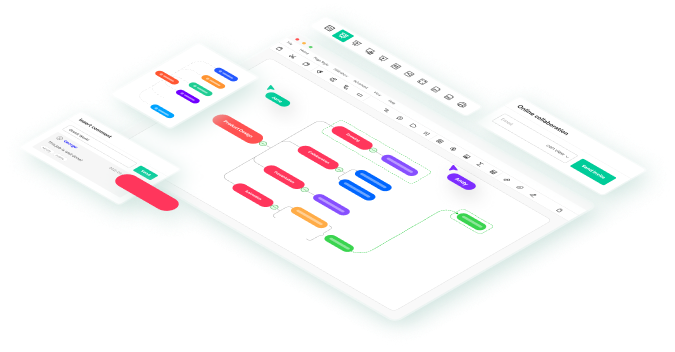
Thought mapping is the graphical recording of knowledge that never becomes formal documentation. It is what exists in employees’ minds. Unlike mind maps, thought maps have cross-linkages, labeled connections, linking phrases, and hierarchical structure. These maps are widely used in recording workflows, problem-solving, and communicating information.
Do you confuse thought maps with concept maps like many of us? No worries. This article explores mind mapping definitions and examples in detail. It further demonstrates how to build a thought map using intelligent mind-mapping software.
In this article
Part 1: Thought Mapping Examples
Want to know more about thought map characteristics? Check out these map templates from the EdrawMind template gallery. You may also visit the software to explore similar examples.
Example 1. Investigative Thinking Map
Thought mapping aids students in elevating their research projects. This investigative map demonstrates a structured approach toward topic organization, connection building, and action items. The different-format branches and connectors convey deeper information between variables for viewers' convenience.
Example 2. Project Management Thought Map
This project management thought map is a road map for corporate workers to plan and organize effectively. It has visible dividends, action items, and sufficient space to brainstorm. Such maps help teams collaborate and generate new ideas that may not have been discussed. Overall, it has a straightforward structure with expandable branches and visual harmony.
Example 3. Event Planning Thought Map
Planning an event means undertaking responsibilities and assigning roles. While at it, a thought map might help you track the progress of the on-field activities. This event planning map illustrates interdependent tasks like managing tasks like allocating the budget, setting the agenda, and managing logistics.
Example 4. English Grammar Map
Language learning is easier with well-structured thought maps. This English syntax map is highly recommended for students struggling with grammar rules. The creator has leveraged key phrases and a right-map-like structure to build an easily understandable information pattern. Anyone can get the jist of grammar by giving this map a quick look.
Example 5. Nervous System Thought Map
This nervous system thought map illustrates the peripheral and central nervous systems and their elements. The creator has used arrows and cross-linkages to connect interdependent topics. The labeling conveys loads of information. Moreover, unlike mind maps, no hierarchy is followed in thought mapping.
Example 6. Nursing Management for Dextroamphetamine Therapy
Nursing students use thought maps to improve their theoretical and practical knowledge of concepts like Dextroamphetamine therapy. The maps use labeled connectors and interdependent topics to demonstrate decision-making, assessment, and practice. In addition, the colorful nodes help viewers differentiate between topic categories at first glance.
Part 2: How to Make a Thought Map in EdrawMind?
Thought mapping is all about building cross-linkages, linking words, better organization, and using the space effectively. So, if you want to make a thought map, drop the pen and paper method and switch to EdrawMind. Its clipart, formatting options, and premade templates simplify the creation process. Here is how it goes.
Before you begin, download, install, and launch the EdrawMind desktop version. Or, you can try it online for free. Log into your Wondershare ID or access the software using your social media account.
Step 1:
Go toTemplatesfrom the main menu and type Thought Maps in the search box. It will display several examples. Scroll down to find the best match and click Duplicate. Once decided.

Step 2:
Alternately, click Create > Mind Map from the dashboard. You will see a preset thought map structure on the editing panel.

Step 3:
Adjust the map layout on the screen. Navigate to the Start tab at the top and add or replace Topic, Sub-Topics, Floating Topics, etc.

Step 4:
Now, it's time to start writing. Double-click any topic box to add a text description. You can also change the font style and size from the on-screen prompt.

Step 5:
Thought maps always look better with visuals. So, go to the Insert tab at the top and click Pictures > AI-Generated, Pictures, etc. You can also use the clipart from the right-side information panel to engage the viewers.

Step 6:
Congratulations, the map is almost done. All it needs is some visual details. Go to the Page Style tab at the top and change its theme, color scheme, and background image.

Step 7:
Finally, you can download your thought map by clicking the Export icon on the quick-access toolbar and selecting a preferred option (e.g., PNG, JPG, PDF). You can also share it with team members and colleagues.

Part 3: Why Choose EdrawMind for Thought Mapping

Digital tools like EdrawMind are dynamic for brainstorming and idea generation. It is a collaborative, full-featured mind map maker that combines AI and graphic assistance. Its resourceful templates, AI tools, and intuitive interface make it unique. Plus, the flexible pricing attracts massive subscriptions. Here is all about this mind-mapping tool.
Working Modes
EdrawMind supports three working modes for different purposes.
Mind Map Mode

The EdrawMind Mind Map Mode allows visual idea generation. It features expandable branches, preset mind map structures, and graphic assistance. You can produce striking maps with reference attachments, vector clipart, and fun color schemes here.
Outline Mode

The Outline Mode of EdrawMind offers a dynamic brainstorming experience with a linear layout. Switch to this mode for rearranging, editing, and inserting data for easy comprehension. You can even switch from mind maps to outlines for memorization and note-taking. Just enable the outline mode from the top-left corner and start editing.
Presentation Mode

Want to display your work directly from EdrawMind? The Presentation Mode might be it. This mode enables users to produce slides of their mind maps in minutes and present them on a full screen. Recently, EdrawMind also launched an AI presentation. It leverages smart algorithms to produce extensive slideshow on any topic. Just enable this mode from the top-left corner and make a query.
Key Features
- Collaborative workspace: Want to discuss a project with the team or organize brainstorming sessions? EdrawMind has a personal Cloud space. It allows communication with team members and external clients. Even better, the manager can control who views and edits the projects.
- Import mind maps: You do not have to give up on editing scope with EdrawMind. It enables users to import their mind maps from other platforms, including XMind, EdrawMax, and MindManager.
- Preset structure: EdrawMind features 22 preset structures for mind maps, tree maps, fishbone diagrams, and other diagrams. So, putting minimal effort into the creation process is a great help, especially to newbies.
- Easy-to-customize templates: EdrawMind supports a gallery with numerous mind map templates for educators and corporate officials. Head to the software and find an easy-to-edit mind map specific to your task, saving time and effort.
Reasons to Try
- Beginner-Friendly interface: Idea generation is effortless with EdrawMind’s easy-to-understand interface. The drag-and-drop functionality and preset structures are excellent for freshers to get a hold of.
- Value for money: EdrawMind supports one free and several flexible paid versions. So, whether you are a student with a low budget or a small startup company, EdrawMind has subscription plans for all.
- Productive: EdrawMind features a collection of AI tools, including presentation, research, drawing, translation, and OCR text extraction. These tools help companies streamline their routine work and focus on significant tasks.
Pricing Plan
EdrawMind has several subscription plans for companies, individuals, and educators. Head over to thesoftware’s pricing page to learn more about the latest pricing.
Part 4: Tips for Effective Thought Mapping
Thought mapping is a dynamic tool for organizing thoughts and visualizing connecting between ideas. Here are a few tips for you to think critically like a pro.
Create a Parking Lot for Ideas
Before you start plotting ideas on the map, list them in an outline. It can help sort the topics in order of significance and relevance. You will also be able to filter out better ideas with this technique, improving the coherence.
Use Labelled Connections
Go beyond arrows and use labeled connections. Linked titles are the backbone of thought mapping, as they aid creators in establishing strong relationships between topics. However, avoid long sentences and difficult vocabulary.
Leverage Visual Elements
Graphic elements like colors, clipart, and shapes enhance the clarity and understanding of your thought maps. With EdrawMInd’s powerful toolkit, you get several design elements to improve the appeal of your map and convey information effectively. Just give it a shot; you will surely find a difference.
Ask for Feedback
A second suggestion is always helpful. Share your thought maps with team members and peers to know what can be improved. For freshers, ask them whether the ideas are organized and if the map needs additional topics.
Revise and Refine
Thought mapping is an iterative process, meaning you update them consistently to gain a deeper understanding. The key is being open-minded about rearranging ideas and refining relationships. So, revisit your thought map and reflect on your strategy; you will be amazed by the outcome.
Conclusion
Thought maps are widely confused with concept and mind maps, so many wonder what is thought mapping for students and corporate officials. For freshers, it is a visual documentation of the information that stays in their minds rather than making it on paper.
Like concept maps, thought mapping can be intimidating due to the elements used, such as cross-linkages, labeled connectors, and linking phrases. It’s best to switch to digital mind-mapping tools like EdrawMind. Its preset structures, advanced connectors, and premade templates reduce the creation time in half. So, give it a shot; you may like how easy it is.





 below.
below.  below.
below. 




